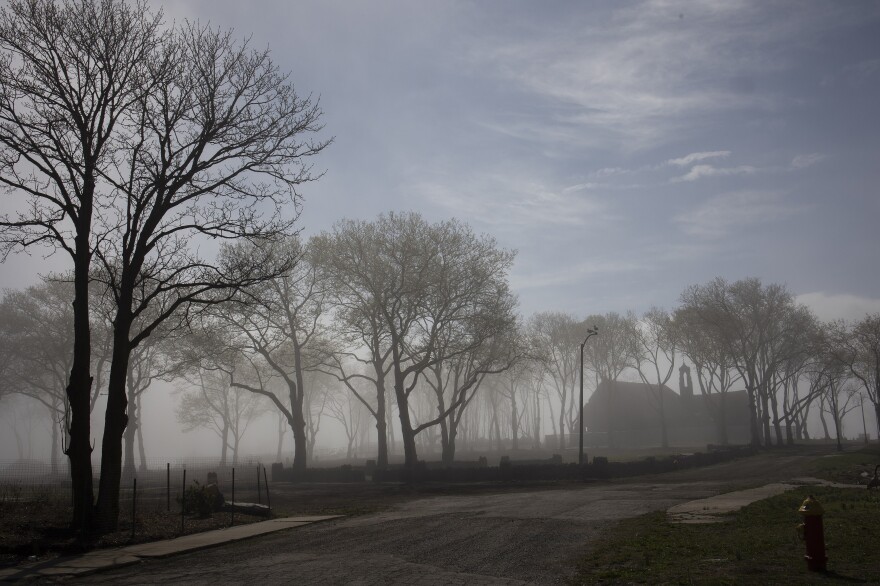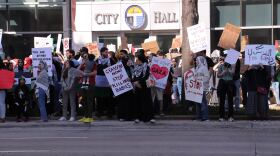This is the seventh and final story in The Unmarked Graveyard: Stories from Hart Island series from Radio Diaries. You can read and listen to previous stories in the series here.
When Annette Vega was in elementary school, she learned that her dad was not her biological father. She didn't think much of it at the time — she had a happy childhood and loving parents.
But as she grew older and became a mom at the age of 18, she began to think about the father with whom she shared DNA. So she set out to find him, with little more than a name: Angel Alberto Garcia.

A teenage romance
Vega's mother, Jeanne Ortiz, was 16 when she met Garcia in 1969. He worked at the local auto body shop and was a handsome, confident young man with green eyes. Everyone called him "Machu."
"He was a bad boy," Oritz recalls. "He used to steal cars, and I think he used to steal cars just for the fun of it."
The two teenagers spent time together taking car rides through the Bronx. "He was sweet. He was good to me," Ortiz recalls. "He talked about the future, when we got married. He was a charmer, let me tell you."

Ortiz became pregnant and gave birth to Vega in April 1970. But her relationship with Garcia didn't last. She told Vega about one of their last conversations: "I was insulting him. I told him that he was not your father, that he was only a father because he made you, but not because he raised you or supported you. I knew that that would hit him hard."
Garcia disappeared after that and Ortiz didn't know what happened to him.
The Ching-a-Lings
Vega began searching for her father online using only his name and his mother's name. With so little information, she hit a lot of dead ends. Then she heard a rumor that Garcia might be a member of the Ching-a-Lings, a predominantly Puerto Rican motorcycle club that identified as outlaws — with a reputation for violent behavior and drug dealing. She decided to follow the lead.
Vega found the Ching-a-Lings' headquarters in the Bronx — a building painted black, with a line of motorcycles out front and people hanging out on the stoop. She approached apprehensively, explaining that she was trying to find her father.

She told the Ching-a-Lings everything she knew: that his name was Angel Garcia, he had green eyes and everyone called him "Machu." A woman smoking a cigarette recognized the description — he had taken care of her after a night of hard partying. She described him as a "nice guy," but hadn't seen him in years. Another dead end.
"I felt kind of silly, looking for so long without a real reason as to why I was looking for him," Vega, now 53, told Radio Diaries. "I didn't need him to be my father. I still really wanted to find him." She also wanted to find and reconnect with his side of the family.
Finally, a DNA match
After doing a DNA test, Vega finally matched with a distant cousin on Ancestry.com who told her that Garcia had a sister who was a teacher. The sister's name was Miriam Garcia and she lived in Florida. Coincidentally, just 20 minutes from where Vega was living.
Vega was excited, but nervous. What would her aunt think about a stranger showing up, claiming to be her niece? She crafted a lengthy, carefully-worded message to Miriam's son on Facebook, explaining who she was and how she found them. "That evening, my phone rings. I hear this woman crying, emotional. She says, 'Annette, mi sobrina, mi sobrina. Tanto tiempo que te estaba buscando.' All this time, my niece, I've been looking for you!"
Vega had found her father's family.

She visited Miriam at her home in Florida in April 2023. They sat down together and Miriam began sharing stories about Garcia's past.
Growing up, the family lived in Puerto Rico and they had a difficult childhood. Their father was an alcoholic, so as a teenager, Garcia left home and started living on the streets.

Miriam says he was later arrested on a drug charge and sent to a minimum security prison called Campamento Guavate De Cayey. Miriam would visit him and bring food, and in return, he'd make gifts for his family. It was around this time, in the mid 1980s — when Vega would have been a teenager — that Garcia told Miriam he was HIV positive.
Miriam recalled the day police officers came to the house, looking for her brother. The officers informed the family that he had escaped from Camp Guavate and was on the run.
Finding Garcia
Miriam remembered receiving a call from Garcia in 1989. He was calling from a payphone in New York City and was very sick with pneumonia. That was the last time she heard from him.
Learning this 30 years later, Vega suspected he was dead. She knew the AIDS epidemic had hit New York City very hard in the 1980s, and if he'd fallen ill with pneumonia it was unlikely he would have survived. But she wanted proof.
She found an online database run by a nonprofit called The Hart Island Project, containing records of people buried in America's largest public cemetery, off the coast of the Bronx.

There were several Angel Garcias in the database. One entry was for a man who died at Elmhurst Hospital in Queens on August 3, 1989, at the age of 37. The dates matched up. Vega requested and received a death certificate and an autopsy. The report said that the immediate cause of death was pneumonia, due to AIDS, as a consequence of chronic intravenous narcotism.
Vega went to her aunt Miriam's house and showed her the documents. She remembered her aunt turning to her and saying, "This is him. You found your father."
On a foggy Sunday morning this past Spring, Vega and her daughter drove to a pier in the Bronx to catch the ferry to Hart Island, a small strip of land where more than a million people are buried.
Waiting by the dock was her half brother whom she had never met: 43-year-old Angel Garcia, named after their father. The two siblings were nervous, but they embraced each other.

The ferry brought them across the sound, where they boarded a small bus which drove around the island making stops at different graves. A park ranger escorted Vega and her brother to a white post with the number 201 painted in black.
This was where Angel Alberto Garcia was buried, in a pine coffin along with about 150 other people in a mass grave. There were no individual headstones or plaques.
Vega brushed her fingers across the white marker and bent down to plant some flowers. She began sharing stories from her more than 30-year search, and in return, her brother shared the few memories he had of their father.
When she first learned about Hart Island, Vega was disturbed that this was where her father was buried. Her brother was too and wanted to disinter him, to give him a "proper burial." But their views both seemed to soften as they stood by the grave.

"It's nicer than I thought," Vega said. "You hear the sounds of nature, the birds, there's no highway running through here. The fog just erases the city. It's just so beautiful."
"I'm happy to see where he lays," responded her brother. "To tell him like, 'Yo, Annette found you, she found us, and we're here — and now we know where you are.'"
After 150 years of being mostly off limits, this past week, New York City's parks department began hosting its first public tours of Hart Island.
This story was produced by Nellie Gilles of Radio Diaries. It was edited by Joe Richman, Deborah George and Ben Shapiro. Thanks also to Alissa Escarce, Mycah Hazel and Lena Engelstein of Radio Diaries. You can find other stories from Hart Island on the Radio Diaries Podcast.
Copyright 2023 NPR. To see more, visit https://www.npr.org.







